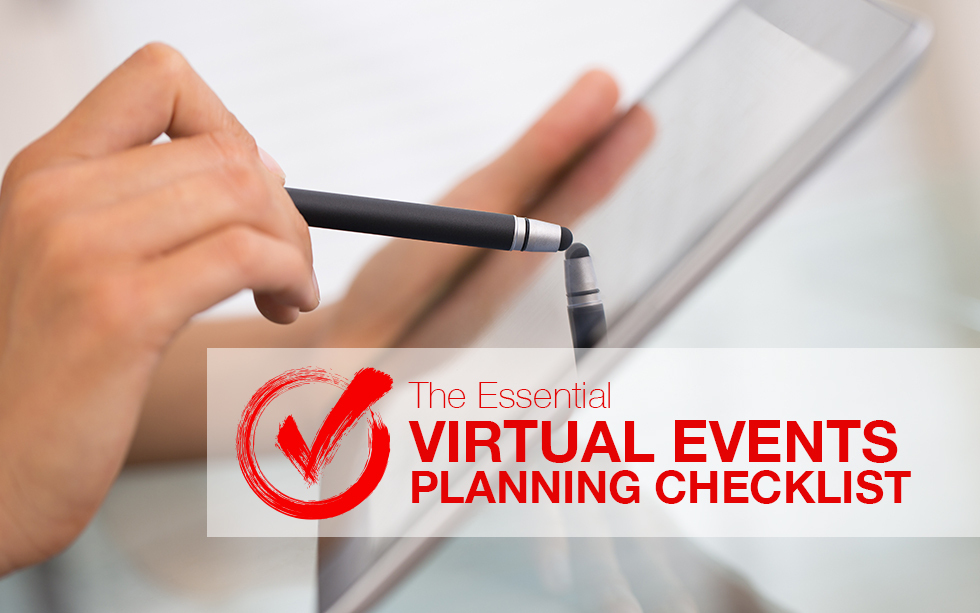The Essential Checklist for Virtual Event Planning
Ask any planner about their most valuable tool, and most will sing the praises of checklists. With endless details to keep track of pre-, during, and post-event, a list makes the to-dos more manageable and provides sanity-saving peace-of-mind too.
Of course, there isn’t a “one size fits all” checklist – especially when it comes to planning virtual events.
Here is an essential planning checklist to get started, which can be tailored for your specific virtual event to stay on track, on-time, and on-budget.
At least three months before the virtual event:
Establish your virtual event goals and objectives – the “why?”
Define target audience(s)
Determine the virtual event format (e.g., all live, simulive, or pre-recorded)
Develop a master event brief and a preliminary schedule of activities, and continue to update/revise as details are adjusted/confirmed
Define your event support team – including both internal and external members – and which may be expanded from the typical in-person team
Decide if the event is free to attend, or if there is a registration fee
Create a preliminary budget
Select the event date(s) and time(s)
Create a marketing plan and timeline
Create branded materials (i.e., logo, tagline, event description, benefits, etc.)
Identify and begin to confirm speakers, presenters, hosts and/or other entertainers
If applicable, develop sponsorship packages and begin soliciting partners
Two months before:
Select technology vendors and start setting up the platforms, including registration/ticketing, video/livestream, audience engagement tools, etc.
Define and assign support team roles for pre-production and run-of-event (speaker support, technical support, customer service, social media, A/V, etc.)
Launch promotional plan, including virtual event website and/or landing page with registration/ticket sales. Don’t forget to create and enable various email confirmations and reminders.
If applicable, create dedicated social media profiles for your event
Start event promotion, including emails, social media posts, press releases, mobilizing influencers, listing your event on online event calendars, and more as needed to support specific goals
Coordinate and place orders with other support suppliers (virtual swag providers, at-home food delivery, etc.)
Create a preliminary rehearsal and production schedule for pre-recorded elements
Confirm presentation topics and descriptions, gather bios and photos from all speakers/presenters, and have contracts signed (if applicable)
Request logos from sponsors
If appropriate, provide speakers with branded presentation templates to use when creating their content
One month before:
Regularly check registration numbers and progress to sponsorship goals
Continue the marketing and promotion plan to encourage registrations and/or ticket sales
Remind speakers/presenters to continue promoting the event to their networks
Draft any needed scripts (i.e., host welcome, speaker introductions, closing remarks, etc.)
Update speakers/presenters with rehearsal and recording schedules
Provide sponsors with marketing materials, and ask them to promote to their databases
Two weeks before:
Draft and send press releases about important event details, including keynote or celebrity speakers, new product information, honorees, etc.
Test the platforms
Start mailing out swag boxes
Review presentations from speakers, and finalize any edits
Finalize script for host
One week before:
Develop back-up plans for various scenarios (speaker difficulties, technology outage, announcing a change in schedule, etc.)
Begin briefing all support staff about the schedule and their roles during the event
Conduct rehearsals for all speakers, including testing individual audio and lighting set-ups
Do a dry run of the entire event on the live streaming platform, including transitions, video rolls, audience interaction segments, etc.
Set-up any audience polls or Q&A used during the event
Create a FAQ document for attendees, including instructions to access the event, troubleshooting tips and how to contact support
Prepare and set-up real-time and post-event surveys for attendees, speakers, and sponsors
One day before:
Send a reminder email to registrants, including login instructions and the event schedule/program
Run another livestream test
Day of the virtual event!
Rise and shine early to do another technical run through and verify everyone is ready to go
Send a final reminder email to registrants
Share and post real-time takeaways or news on social media channels
Post-event:
Conduct a debrief to gather feedback from internal team members – what worked well, and what to improve for the next virtual event
Send thank you emails, including post-event surveys and links to any recordings if applicable, to attendees, speakers, and sponsors
Send a separate email to those who registered to attend but didn’t, with a link to any recordings
Create a post-event report, with a summary of key results compared to objectives, feedback and lessons learned
Prepare a video highlights reel to share via email to participants, or to post on social media or your event website
Update the event website to announce the date for the next event, if known
Update budget with all final invoices and costs
Begin thinking about and planning the next virtual event!
To gain more insights into all of the ins and outs of planning a successful virtual event, register for our Virtual Event and Meeting Management Certificate course. Earn 20 CMP hours and learn how to develop a strategy that includes key components unique to planning virtual events.



This is awesome, thank you!
Given the high demand for these types of events now and for the foreseeable future I would recommend pushing everything out 1 month at a minimum…for a full scale virtual event 16-20 weeks is much safer and will ensure success and high level of quality. Just my two cents.
Great info!
THANK YOU!